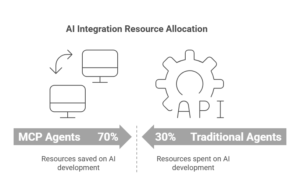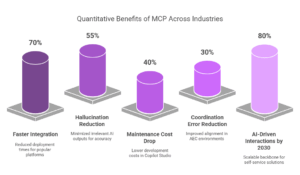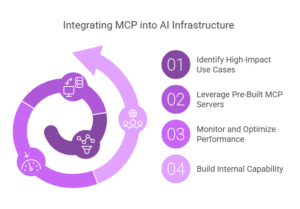
The demand for intelligent agents that can operate in real time with real-world data and tools is increasing dramatically, as is the rapid evolution of artificial intelligence. They are handling end-to-end workflows spanning enterprise automation and customer support from finance to legal to software development.
Yet there is still a major hurdle: integration. Most AI agents today rely on API or database-based brittle one-time integrations that do not scale well and often remain devoid of context. Enter the Model Context Protocol (MCP), an amazing open standard developed by Anthropic.
MCP dramatically redefines how AI agents would communicate with external tools, such that that communication may be entirely dynamic in both directions with context retention.
This article considers how MCP is tackling long-standing problems in AI integration and setting the stage for truly intelligent, context-aware and scalable AI agents.
Key Challenges in Traditional AI Integration
Generally, for each external tool that AI agents interact with, a custom API has to be developed. All this results in a fragmented, difficult-to-structure, time-consuming, and costlier maintenance architecture.
In an enterprise setting, 70% of the resources spent on AI development go to managing the related AI integration. In fact, most traditional agents suffer not only context loss but also fail to carry task-relevant information from one tool to another.
MCP as the Solution
Launched by Anthropic, the MCP features a common, vendor-independent protocol that standardizes the interchange of information between an AI agent and the outside world.
Agents can thus send queries to retrieve information and perform actions (for example, updating a record or sending an alert). It allows tools to dynamically discover other tools through automatic registration with MCP servers while remaining agnostic to the model so that developers may simply swap out AI models and not re-code integrations.
This reduces complexity, speeds up the time to market, and hugely improves context retention.
Architecture & Workflow in Action
MCP Architecture in Brief
|
Component |
Role |
|
MCP Client |
The AI agent, sending queries to request data or perform actions. |
|
MCP Server |
Connects tools/data to the agent via secure, standardized endpoints. |
|
Host Application |
Manages routing, authentication, and execution. |
Its architecture, therefore, lends itself to seamless integration in different scenarios such as cloud, on-premises, or hybrid.
By dealing with security, access control and protocol translation at the server level, MCP ensures that its AI agents operate securely and efficiency across the enterprise systems.
It allows a unified face, whether it be cloud-based CRM or an internal file system or API calls onto a legacy system, easing developer use and enhancing agent capability.
Real-World Example: Legal Document Review
Consider a document review workflow:
- An AI agent integrated with MCP monitors a Nasuni file system for new legal documents.
- Upon detecting a contract, the agent initiates Retrieval-Augmented Generation (RAG) to extract and interpret key legal clauses such as indemnity, liability, and termination terms.
- The agent then accesses a historical contract repository via a Postgres MCP server, comparing extracted clauses with precedent agreements to identify deviations or risks.
- When inconsistencies are found, the agent flags them and logs entries in the enterprise CRM, assigns review tasks to legal staff, and updates the status dashboard.
This webinar demonstrates how the MCP enables AE to string together several individual systems into a unified, automated pipeline-from file detection to clause cashing to CRM updating, all in one intelligent workflow.
Outcome: 70% faster contract review cycles, improved consistency, and reduced manual review fatigue.
Quantitative Gains
MCP delivers a host of quantifiable improvements across industries:
- 70% faster integration: Organizations using pre-built MCP servers for popular platforms like GitHub, Slack, and Postgres experience significantly reduced deployment times.
- 55% reduction in hallucinations: Enhanced context awareness minimizes irrelevant or incorrect AI outputs, leading to more accurate interactions and decisions.
- 40% drop in maintenance cost: Microsoft’s Copilot Studio saw a substantial decline in ongoing development costs thanks to MCP’s support for dynamic tool updates.
- 30% fewer coordination errors: In Architecture, Engineering, and Construction (AEC) environments, MCP-powered agents link regulatory data, design files, and communications to reduce misalignments.
- 80% of interactions projected to be AI-driven by 2030: MCP’s ability to scale reliably makes it the backbone of self-service solutions.
These metrics underline MCP’s effectiveness in making AI systems more practical, sustainable and enterprise-ready.
Use Cases
MCP’s versatility has been demonstrated across multiple domains:
- Block (formerly Square): Leveraged MCP to create intelligent payment fraud detection agents that monitor transactions, cross-reference behavioral patterns, and escalate issues without human input.
- Microsoft Copilot Studio: Used MCP to maintain consistent integration across tools as internal systems evolved, reducing downtime and developer friction.
- AEC Industry Leaders: Integrated MCP with Building Information Modeling (BIM) systems, municipal regulation databases, and project management tools to improve compliance tracking and reduce delays.
- Customer Support Automation: Enterprises using MCP-enabled agents to manage incoming tickets, triage based on urgency, pull customer histories, and propose solutions—all autonomously—have reported improved customer satisfaction scores and lower resolution times.
- Legal and Compliance: Law firms and compliance departments are deploying MCP agents to flag inconsistencies in contracts, regulatory submissions, and audit trails, improving turnaround speed while minimizing risk.
These real-world applications prove MCP isn’t just a technical advancement—it’s a strategic lever for business innovation.
Getting Started with MCP
For organizations seeking to integrate MCP into their AI infrastructure, a focused, phased approach is recommended:
1. Identify High-Impact Use Cases
Begin with workflows where the return on investment is clear—such as automating contract reviews, customer service interactions, or QA processes. Look for tasks that are repetitive, data-intensive, and prone to context-switching inefficiencies.
2. Leverage Pre-Built MCP Servers
Anthropic and open-source communities offer MCP server implementations for platforms like Slack, GitHub, Notion, Postgres and more. Using these servers reduces setup time and allows teams to experiment with MCP integration without building everything from scratch.
3. Monitor and Optimize Performance
Implement monitoring tools to measure:
- Latency between agent requests and tool responses
- Token efficiency and cost per transaction
- Context retention success rates
- Task completion metrics (e.g., contracts reviewed per hour, support tickets resolved)
These metrics can help fine-tune both infrastructure and agent behavior, ensuring scalability as usage grows.
4. Build Internal Capability
Train internal teams on the MCP specification and its client-server architecture. As more workflows move under AI orchestration, in-house capability becomes essential for long-term maintenance and expansion.
Conclusion
MCP aims to provide a scalable, secure, and intelligent route through which businesses can build AI agents that automate tasks with complete awareness and adaptability.
With capabilities like dynamic tool integration, real-time data access, and vendor-agnostic operations, MCP resolves not only the integration problems but also works on constructing a foundation for the next development stage in enterprise AI.
When enterprises consider a smarter, faster, and more efficient path to AI deployments, MCP stands as the bridge between their lofty aspirations and their realistic, implementable practices.




